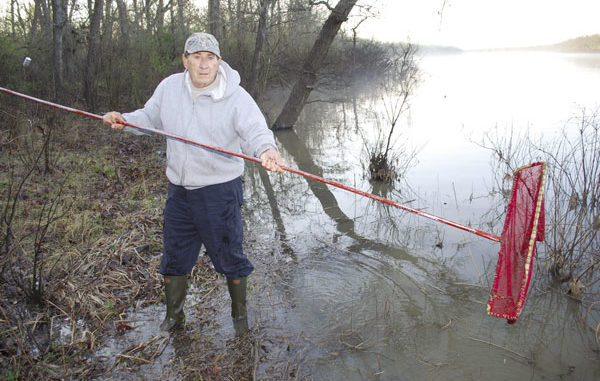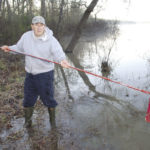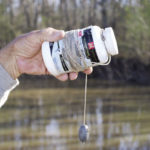
The Saline-Larto complex churns out white perch like a finely tuned assembly line.
Saline-Larto. The name kind of has a ring to it, like a gang of bank robbers from the Wild West. Or maybe a gunslinger — I can hear it now, “Watch out, that’s the Saline-Larto Kid!” But to Louisiana outdoorsmen, Saline-Larto means one thing — white perch, and lots of them, those black-speckled silvery bags of succulent, milky white flesh.
South Louisianans call them sac-a-lait, bookworms call them crappie and some folks not from here, for whatever reason, call them bachelor perch. But in central Louisiana — Saline-Larto country — they are white perch.
H.L. Mencken, the “Sage of Baltimore” and probably the greatest-ever American journalist, coined the term “immense protein factory” to describe the Chesapeake Bay and its seafood production. (Mencken had a way with words. He once called New York City a “third-rate Babylon.”)
Mark Reisner, director of communications for the lawyer-heavy Natural Resources Defense Council, borrowed Mencken’s term in 1991 to describe the Saline-Larto complex in his book Game Wars. A chapter in the book, which was about legendary federal game warden Dave Hall’s exploits, was devoted to Hall’s efforts to break up the large illegal white perch fishery in the area.
“Protein factory” aptly fits the tangled rete of bayous and water bodies that dominate this vast bottomland hardwood floodplain between Jonesville, Jena and Marksville. The complex includes 18 named bayous, a whole passel of smaller sloughs, cutoffs, glades, forks and branches, three major lakes — Catahoula, Larto and Saline — and Shad Lake, a smaller water body.
Three significant rivers, the Red, Black and Little, all feed and drain the system.
Since before World War II, the complex has churned out untold tons of white perch to be illegally sold, both locally and at points as distant as Memphis and Chicago. Several generations of dedicated game wardens have slowed the trade, but it still hangs on, like an ingrown toenail.
During this same time, a world-class crappie fishery developed in the complex, and exists to this day. People travel from all parts of this state and from far beyond the state’s borders to partake of the bounty. The ability of these waters to produce white perch is prodigious.
Bob Jeansonne has spent the last 20 years chasing Saline-Larto white perch from his camp in Cross Bayou Campground. Home to 86 fishing camps on a 40-acre patch of private ground in the heart of the massive 61,871-acre Dewey Wills Wildlife Management Area, the campground has a distinctively rustic appeal.
These are not luxury camps; they are fishing camps, pure and simple. Many, like Jeansonne’s, are very comfortable. But he stresses that without the fishing he wouldn’t have the camp.
“This is white perch heaven,” he says matter-of-factly.
At 70 years old, Jeansonne, a retired bank vice president from Rapides Parish, is still fit and trim. His twinkling cornflower blue eyes and shock of Ronald Reaganesque hair make him ruggedly “western cowboy handsome.”
A self-avowed fly-rod aficionado for bream when he bought the camp, it didn’t take him long to pick up the addiction to white perch that afflicts all the other camp owners.
“It’s still a good bream place, but it is a better white perch place,” he said “My true love is fishing for white perch.”
At the crack of daylight, Jeansonne launches his modest 14-foot aluminum flatboat, powered by a 50-horsepower engine, at Phil’s Landing, a launching point that dates back to 1935. Before launching, he stows his gear in the boat, a couple of Zebco spincast rigs and a pair of 16-foot Wally Marshall graphite jig poles mounted with West Point crappie reels for line storage.
He makes sure that he doesn’t forget his odd square bait dip net and small plastic bucket to hold the bait. The most unusual item that he adds to the boat is a set of chest waders.
It’s March, and it’s nippy, in spite of the great orange gob of sun slowly crawling over the tree line into a turquoise sky. Streamers of steamy haze rise from the warmer water into the air as Jeansonne heads for a spot to dip for bait.
He is looking for submerged grassy areas that are likely to harbor what he calls his secret weapon — grass shrimp. At a likely spot, he eases through the shallow water on foot, pulling his dip net along the bottom toward him. The net is homemade, with a frame constructed of steel re-bar that he heated with a propane torch and bent. The mesh bag is constructed from a recycled football practice jersey.
Jeansonne is handy, and likes to make much of his own equipment. His wife, Billie, his regular fishing partner says, “Bob can make a penny squeak.” Only a wife can get away with that.
As he sorts the tiny crustaceans from the grass in the bucket, he grumbles about grass shrimp being scarce right now.
“I tend to want to not fish at all if I can’t get shrimp,” he said. “I guess that I have convinced myself. In years past, I have caught a lot on just plain jigs.”
Armed with bait, he looks for fish. He hasn’t gone far. He is still within a half mile of the landing. He clamps a homemade probe to the gunnel of the boat beside his bow seat. On the end of the probe are side scan and vertical transducers for his fish finder.
He idles the boat slowly, sitting in front of the console, steering behind his back and marking fish on the screen of his fish finder. When he sees enough fish at a consistent depth, he stops and begins fishing with his jig pole.
Each jig pole is equipped with 8- or 10-pound-test Golden Stren line. The line’s high visibility allows him to see the lure stop falling or any twitch in the line, either of which signals a bite. Jeansonne never uses a cork on his jig pole.
Jig heads are 1/16-ounce when fishing in deeper water like now, 6 to 9 feet deep, and 1/32-ounce when fishing for white perch “in the bushes” on their spawning beds in shallow water. He clamps on the smallest split shot available about 1 foot above the jig head when fishing open water, but will remove it when fishing in the bushes because it will hang up.
After the tube jig is put on the jig head, Jeansonne threads on a yellow Berkley PowerBait Crappie Nibble. Then, he follows the nibble with a grass shrimp, threaded head first.
“This actually makes the bait semi weedless,” he explains.
He moves the boat constantly and probes in every direction and at depths down to 9 feet with his jig pole. He regulates line depth partly by stripping and wrapping the monofilament with his left hand while he controls the pole in his right.
He picks up a couple of fish, but lays the pole down to give his rod and reel a try. He leaves the jig pole’s jig overboard.
“Sometimes I catch as many doing that as I do working it,” he says.
Unlike with the jig pole, the line on the rod and reel has a cork mounted about 2½ feet above the jig. During the retrieve, Jeansonne constantly jiggles the corked line.
Whether on the rod and reel or the jig pole, Jeansonne always ties his line directly to the jig head. He emphasizes that it is very important that the knot be pushed to the rear of the eye of the jig head. ‘You won’t catch half as many fish if the knot is on top of the eye,” he explains. “But you must have a snug knot to do that.”
Jeansonne always buries the head of the jig inside the tube jig, explaining that it is easy to do if you start the hook 1/8 inch back from the tip of the tube. Although he started with a pink/white tube, he says that blue/white has been his favorite color for many years.
“If you don’t catch them on blue/white, you are fishing in the wrong place or the fish just aren’t biting,” he said.
As it warms up, Jeansonne speculates that the male white perch may have moved into the bushes to prepare their spawning beds. Almost all the bayous and waterways of the Saline-Larto complex are lined with dense growths of shrub-sized buttonwoods, or “button willows,” as he calls them. These woody plants routinely grow and thrive in water up to 2½ feet and provide a sheltered location for white perch to spawn.
White perch are notorious for spawning in shallow water, sometimes even less than 1 foot deep The dense buttonwood thickets make reaching these shallow-spawning white perch challenging, but when the white perch are in the bushes, so usually is Jeansonne.
Pulling to the bank in an opening in the bushes, he dons his chest waters and quietly slips into the water. He has removed the split shot from above the jig head so that he can pull the lure all the way up to the rod tip to insert it into the densest spots in the thicket. Using his left hand to control the line, just like with a fly rod, he lowers the bait from the rod tip and jiggles the rod with his right hand.
He moves and probes, moves and probes. He catches some small bream, but white perch are slow in the bushes. He talks as he fishes.
“Me and my boys (he has six sons) were some of the first to do this in the late 1980s,” he says. “Now more and more people are wading for them in their beds. You can really work on them this way if you do it right.
“You don’t disturb the fish as much as with a boat, and you can work the entire width of the brush line, from the back to the edge. From a boat, you can only work the edge. Wading also allows you to work more slowly. In a boat, I think that sometimes you don’t give them enough chance.”
But today, it wasn’t to be. The fish weren’t on their spawning beds in the bushes yet.
Back to the boat and fishing in deeper water on the shelves, shoulders and flats of the bayous in 4 to 12 feet of water.
Jeansonne explains that as popular as the Saline and Larto Lakes are, he almost never fishes in the lakes proper, keeping to the miles of bayous in the complex.
“Wind affects you a lot more in the open lakes,” he says, “and the lakes get a lot of boat traffic too. I catch all I want in the bayous.”
Today, the white perch that he is catching are white crappie, but Jeansonne explains that both white and black crappie are present in the complex. He says that he catches more white crappie than black, but prefers the latter.
“Black crappie, the ones I call ‘specks,’ have a firmer meat and fight better than white crappie,” he said. “I find black crappie seem to prefer clearer and deeper water.”
Mixed with his crappie catches are more than a few yellow bass. These fish, which he disdainfully calls “Texas yellow bass,” produce a comical reaction in Jeansonne. Every catch is accompanied by an audible groan. Then he grasps the unfortunate creature with a set of channel lock pliers to hold it while he unhooks it.
“These things are kind of dangerous; their gill covers will cut you like a couple of razor blades,” he said. “I don’t like the aggravation of taking something off the hook that I’m not going to keep.”
Jeansonne continues to peck away at the fish. He is fishing in open water well away from the bank, so when he locates what he thinks is a workable cluster of fish, he tosses over another one of his homemade devices, a marker made of a vitamin bottle with a wheel weight wired to one side of the inside of the bottle. The holes are plugged with JB Weld. They work like a charm.
At the end of a beautiful spring day, Jeansonne retraces his path through Louisiana’s Protein Factory. Billie has promised shrimp creole for the evening meal, something for which to look forward.
“My first love is catching white perch, but you know my second love is eating them,” he says. “That’s why I only want to keep the ones big enough to
fillet.”




